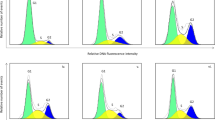Abstract
IN the sugar-canes there are two cytological features of interest. First, it has been noticed that two types of egg gametes, one with the reduced haploid number of chromosomes and the other with the unreduced diploid number, are formed. From a study of chromosome numbers in certain hybrids (Table 1), it can be seen that in some crosses one or other of these types of gametes, or both, have functioned.
This is a preview of subscription content, access via your institution
Access options
Subscribe to this journal
Receive 51 print issues and online access
$199.00 per year
only $3.90 per issue
Buy this article
- Purchase on Springer Link
- Instant access to full article PDF
Prices may be subject to local taxes which are calculated during checkout
Similar content being viewed by others
References
Bremer, G., Proc. Eighth Int. Cong. of Genetics, Supp. to Hereditas, 541 (1949).
Janaki-Ammal, E. K., J. Genet., 41, 217 (1941).
Parthasarathy, N., Report of the Sugarcane Geneticist for 1941–42, Imp. Council of Agric. Res., India (1942).
Subramanium, C. L., Part 1 of a thesis submitted to the University of Madras for the degree of master of science (1946).
Vaarama, A., Hereditas, 35, 136 (1949).
Rajan, S. S., Hardas, M. W., and Parthasarathy, N., Indian J. Genet. and Plant Breed., 10, 43 (1950).
Parthasarathy, N., J. Ind. Bot. Sci., M.O.P. Iyenear Commemoration Vol., 133 (1946).
Author information
Authors and Affiliations
Rights and permissions
About this article
Cite this article
PARTHASARATHY, N. Chromosome Elimination in Saccharum. Nature 168, 383–384 (1951). https://doi.org/10.1038/168383a0
Published:
Issue Date:
DOI: https://doi.org/10.1038/168383a0
This article is cited by
-
Identifying the Risks of Transgene Escape from Sugarcane Crops to Related Species, with Particular Reference to Saccharum spontaneum in Australia
Tropical Plant Biology (2008)
-
Phylogenetic analysis of chloroplast restriction enzyme site mutations in the Saccharinae Griseb. subtribe of the Andropogoneae Dumort. tribe
Theoretical and Applied Genetics (1994)
-
A cytotype from Co. 419 and its origin
Proceedings / Indian Academy of Sciences (1969)
-
Nuclear instability and chromosomal mosaicism in the polyploids ofTrigonella foenum-graecum
Biologia Plantarum (1965)
-
The bearing of certain recent cyto-genetical findings on sugarcane breeding
Proceedings / Indian Academy of Sciences (1956)
Comments
By submitting a comment you agree to abide by our Terms and Community Guidelines. If you find something abusive or that does not comply with our terms or guidelines please flag it as inappropriate.



